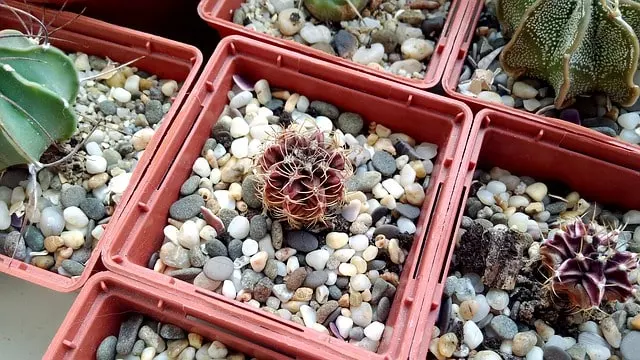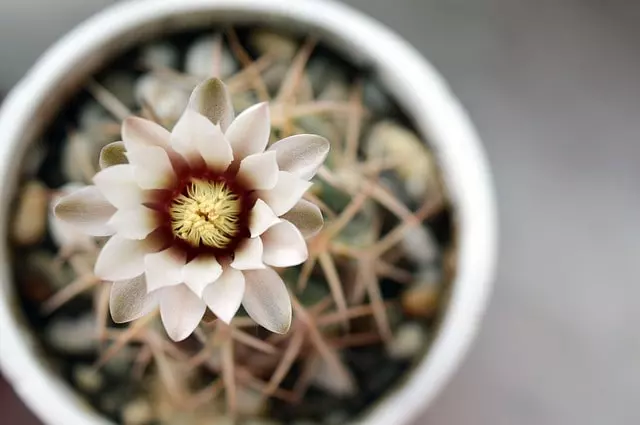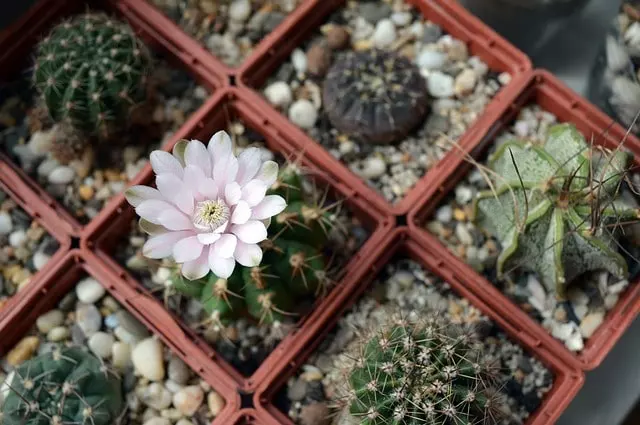Gymnocalycium is small, easy-to-care-for cacti that, despite their small size, have enormous decorative potential thanks to their showy flowers. Since they are undemanding in their care and can be grown in almost any corner, they are very popular for decorating all kinds of spaces.
If you want to learn about the care of Gymnocalycium to have yours in the best conditions and very beautiful, keep reading us in this article.
Table of Contents
Characteristics of Gymnocalycium
Gymnocalycium, popularly called dwarf chin cacti, have the following characteristics and curiosities:
- They are a whole genus of plants of the Cactaceae family.
- It has approximately 60 to 70 species of cacti.
- Almost all of them are native to northern and central Argentina, as well as Brazil, Uruguay, and Bolivia.
- The Gymnocalycium are similar in size and shape, most of them being species of no more than 4″ (10 cm) in height, with diameters of about 2.7″ (7 cm).
- The marked ribs are striking in all species, divided into visible tubercles in most cases.
- From these sprout between 5 and 7 radial spines.
- The showiest and most eye-catching are its flowers, which appear in early summer, at the top of the plant or its offshoots. The flowers of Gymnocalycium have red, pink, or purple colors, appearing even in very young individuals.

Location and Climate
One of the main advantages of these small plant companions is their small size. Thanks to this, we can place them in a large number of locations. Although it is most common and advisable to place them outdoors, this does not necessarily have to be the case: just take care of their needs and you will also be able to grow them indoors.
Gymnocalycium usually needs a location where they receive at least 6 to 8 hours of direct sunlight. However, in the case of chin cacti purchased from a nursery, or grafted species, they have likely been grown in semi-shaded locations, and sudden exposure to direct sunlight could burn them. In these cases, place them indoors, in a well-lit room, or in an outdoor area where they are protected from the hours of the high midday sun. If you want to grow them indoors, do it next to a light source where they receive all possible hours of light, even changing them between morning and afternoon if necessary.
Regarding the climate, ungrafted cacti are quite resistant to cold for cacti, being able to withstand even light frosts of up to 26°F (-3 ºC) for short periods. Grafted cacti, on the other hand, will not tolerate very low temperatures under any circumstances.
Watering Gymnocalycium
As with most cacti and succulents, these small plants do not tolerate excess moisture. Too much or too frequent watering runs the risk of causing root rot, which can easily prove fatal.
Water about twice a week in the warm months if the environment is very dry in your area, and about once a month when the weather is humid or in the cold months. In short, water only when the soil is dry beyond the topsoil.
When watering, however, make sure that the humidity soaks into the substrate, but always without puddling. If you have a saucer under the pot to collect the water from the drainage holes (which are necessary), be sure to remove the excess water about ten minutes after watering.

Substrate and Soil
The most important soil for these cacti is a light mix with the best possible drainage. Outdoors, the rockery areas usually designated for succulents are a great choice as long as they have adequate drainage. Water before planting and check that water does not pool there. We recommend this excellent soil for cacti (Order here).
In pots, any light, airy mix will work well, as it is not a nutrient-demanding plant. Mixing coir fiber with equal parts peat and worm castings, along with an addition of vermiculite and perlite, will usually give good results. You can also prepare a bed of coarse gravel at the bottom of the pot to ensure that it does not accumulate excess moisture.
- Provides the drainage cacti need to flourish.
- You will receive (1) 4-quart bag with this order.
- Ready to use, so that you don’t need to take the time and energy to mix ingredients together.
Fertilizing Gymnocalycium
As almost always, it is highly recommended to fertilize the plant during the warm months to support its development and flowering. In this case, it is very important to use specific fertilizers for cacti and thus not fall into excess nutrients that harm your dwarf chin cactus.
We recommend you to read this other article about the best fertilizer for succulents and cacti, but remember that it is convenient to use nutrients adjusted to chin cacti, so find out more about the necessary nutrients in the gardening store or buy the specific fertilizer.
- Instantly feeds succulent plants, including cacti
- For all cacti, jade, aloe and other popular succulents
- Feeds instantly
How to Propagate Gymnocalycium
Regarding the multiplication or reproduction of the dwarf chin cactus, it is possible to do it by seeds from its fruits, but the method by scions or grafts is very simple and much faster, being successful in a very high percentage of cases. It is advisable to do them always in the warm months, and in the case of the scions, to let them dry for 48 hours before replanting them. Learn more about how to grow cactus from seed.




